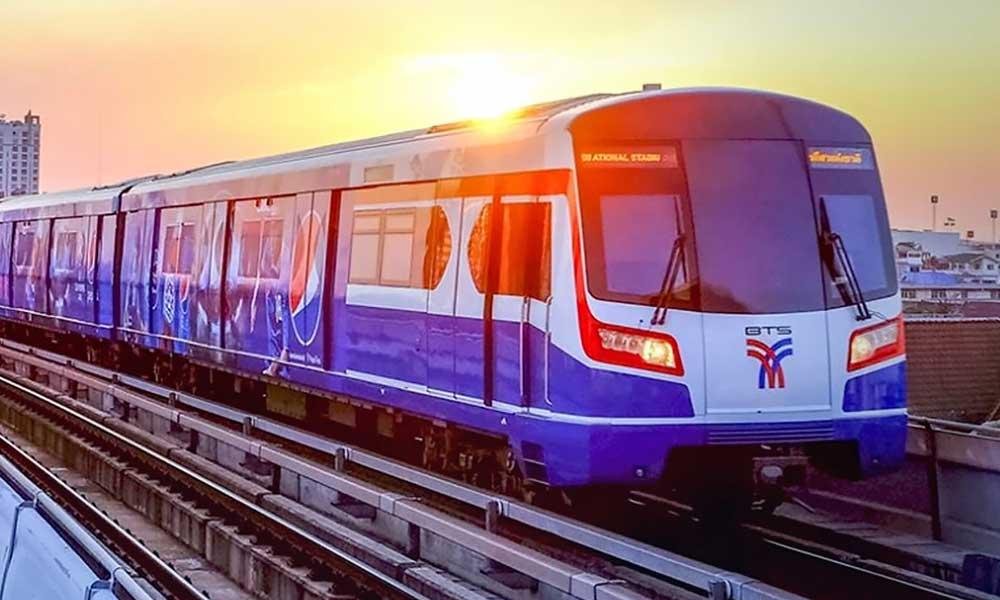Bangkok, the vibrant capital of Thailand, is a city that seamlessly blends tradition with modernity. One of the key elements contributing to the city's efficient and convenient transportation network is the combination of the BTS (Skytrain) and MRT (Metro) systems. In this blog post, we'll explore the significance of these two mass transit systems, how they connect the sprawling city, and the convenience they offer to both locals and visitors.
- BTS Skytrain: Soaring Above the Urban Bustle
The BTS Skytrain stands as an iconic symbol of Bangkok's modernity, providing a swift and elevated mode of transportation above the bustling streets. The two main lines, the Sukhumvit Line and the Silom Line, cover key areas of the city, connecting major business districts, shopping centers, and popular attractions.
-
Efficiency and Speed: The BTS is renowned for its punctuality and speed, making it an ideal choice for both daily commuters and tourists looking to explore the city efficiently.
-
Connecting Key Districts: The Sukhumvit Line stretches from the northern Mo Chit Station to the eastern Bearing Station, passing through central areas like Siam and Asok, while the Silom Line connects the National Stadium in the west to the Chong Nonsi Station in the southeast.
- MRT Metro: Navigating the Depths of Bangkok
Delving into the city's underground, the MRT Metro complements the BTS by providing extensive coverage to areas that may not be as easily accessible by surface transportation. With its own network of stations, the MRT seamlessly interconnects with the BTS, creating a comprehensive transit system.
-
Citywide Connectivity: The MRT covers a wide range of areas, from Hua Lamphong in the southwest to Bang Sue in the north, ensuring that passengers can reach various districts with ease.
-
Interchange Stations: Key interchange stations such as Sukhumvit (connecting with the BTS), Silom, and Chatuchak Park facilitate smooth transitions between the two systems, enabling passengers to navigate the city seamlessly.
- Integration and Interchangeability: The Ultimate Convenience
One of the standout features of Bangkok's public transportation system is the integration and interchangeability between the BTS and MRT. The interchange stations not only facilitate easy transfers between the two systems but also provide access to major attractions and hubs.
-
Effortless Transfers: Stations like Asok and Mo Chit serve as seamless transfer points between the BTS and MRT, eliminating the need for complicated journeys and ensuring a smooth commute.
-
Accessibility to Landmarks: The strategic placement of stations allows travelers to effortlessly reach notable landmarks such as Chatuchak Weekend Market, Lumpini Park, and Erawan Shrine.
- Smart Ticketing and Convenience: Navigating with Ease
Both the BTS and MRT systems utilize smart ticketing systems that make commuting a breeze. From single-journey tickets to rechargeable smart cards, passengers have a variety of options for convenient and cashless travel.
-
Rabbit Card and MRT Card: The Rabbit Card (BTS) and MRT Card are rechargeable smart cards that allow users to seamlessly travel on both systems with a single card, reducing the hassle of purchasing separate tickets.
-
Mobile Apps and Information Centers: Travelers can stay updated on schedules, routes, and promotions through dedicated mobile apps and information centers at stations, ensuring a smooth and informed journey.
Conclusion:
The BTS and MRT systems in Bangkok stand as shining examples of urban transportation done right. Their integration, efficiency, and connectivity make them invaluable assets to both locals navigating the city's daily hustle and tourists exploring its myriad attractions. As you embark on your journey through Bangkok, let the elevated views of the BTS and the underground efficiency of the MRT guide you through the heart of this dynamic metropolis.
การนำทางในเมืองกรุงเทพ: คู่มือการใช้รถไฟฟ้าบีทีเอสและรถไฟใต้ดินเอ็มอาร์ที
บทนำ:
กรุงเทพ, เมืองหลวงที่แสนสดใสของประเทศไทย, เป็นเมืองที่ผสมผสานวัฒนธรรมทางด้านดั้งเดิมและทางด้านทันสมัยอย่างลงตัว. หนึ่งในส่วนสำคัญที่ทำให้เมืองนี้มีระบบการขนส่งที่สะดวกและมีประสิทธิภาพคือรถไฟฟ้าบีทีเอส (Skytrain) และรถไฟใต้ดินเอ็มอาร์ที (Metro). ในบทความนี้, เราจะสำรวจความสำคัญของระบบการขนส่งมวลชนทั้งสองนี้, วิธีที่พวกเขาเชื่อมโยงเมืองที่กว้างขวาง, และความสะดวกสบายที่พวกเขานำเสนอทั้งแก่ประชาชนท้องถิ่นและนักท่องเที่ยว.
- รถไฟฟ้าบีทีเอส: บินเหนือความคับคั่งในใจเมือง
รถไฟฟ้าบีทีเอส (BTS) เป็นสัญลักษณ์ที่โดดเด่นของความทันสมัยของกรุงเทพ, ให้บริการการขนส่งที่รวดเร็วและประสบการณ์ที่สูงขึ้นบนถนนที่คับคั่ง. สองสายหลัก, สายสุขุมวิทและสายสีลม, ครอบคลุมพื้นที่สำคัญของเมือง, เชื่อมโยงเขตธุรกิจสำคัญ, ศูนย์การค้า, และสถานที่ท่องเที่ยวที่มีความนิยม.
-
ประสิทธิภาพและความเร็ว: BTS มีชื่อเสียงด้านความสม่ำเสมอและความเร็ว, ทำให้เป็นทางเลือกที่ดีสำหรับนักเดินทางประจำวันและนักท่องเที่ยวที่ต้องการสำรวจเมืองให้มีประสิทธิภาพ.
-
เชื่อมโยงกับเขตสำคัญ: สายสุขุมวิทยืนครอบคลุมตั้งแต่สถานีหมอชิตทางเหนือจนถึงสถานีแบริ่งทางตะวันออก, ผ่านพื้นที่กลางเช่น สยาม และ อโศก, ส่วนสายสีลมเชื่อมต่อสนามเสือสำนักข่าวในทิศตะวันตกถึงสถานีช่องนนทรีทางตะวันออกเฉียงใต้.
- รถไฟใต้ดินเอ็มอาร์ที: การนำทางใต้พื้นผิวของกรุงเทพ
การศึกษาลึกเข้าไปในใจเมืองผ่านทางรถไฟใต้ดินเอ็มอาร์ที (MRT) ทำให้รู้ว่ามันช่วยเสริมเติมระบบการขนส่งของ BTS โดยให้บริการการเชื่อมต่อไปยังพื้นที่ที่ไม่ง่ายถึงด้วยระบบขนส่งผิวพื้น. ด้วยระบบสถานีของตัวเอง, MRT เชื่อมโยงไปที่ BTS โดยไม่มีขั้ว, สร้างระบบการขนส่งที่ทันสมัยและที่ทั้งปวง.
-
ความเชื่อมโยงในเมือง: MRT ครอบคลุมพื้นที่หลากหลายตั้งแต่หัวลำโพงทางตะวันตกถึงบางซื่อทางเหนือ, ทำให้ผู้โดยสารสามารถเดินทางไปยังเขตต่าง ๆ ได้อย่างสะดวก.
-
สถานีที่เชื่อมต่อ: สถานีเชื่อมต่อสำคัญเช่น สุขุมวิท (เชื่อมต่อกับ BTS), สีลม, และ สวนจตุจักร ช่วยให้การย้ายตัวระหว่างทั้งสองระบบเป็นไปอย่างลื่นไหล, โดยทำให้นักเดินทางสามารถนำทางไปทุกที่ได้อย่างง่ายดา.
- การผสมผสานและการเปลี่ยนแปลง: ความสะดวกสบายที่สุด
หนึ่งในลักษณะที่โดดเด่นของระบบขนส่งสาธารณะของกรุงเทพคือการผสมผสานและการเปลี่ยนแปลงระหว่าง BTS และ MRT. สถานีการเปลี่ยนแปลงไม่เพียงทำให้การย้ายตัวระหว่างทั้งสองระบบเป็นเรื่องง่าย, แต่ยังให้การเข้าถึงไปยังสถานที่ท่องเที่ยวและศูนย์กลางสำคัญ.
-
การย้ายตัวโดยไม่ลำบาก: สถานีเช่น อโศก และ หมอชิต ทำหน้าที่เป็นจุดการเปลี่ยนแปลงไม่เพียงทำให้การย้ายตัวระหว่าง BTS และ MRT เป็นเรื่องง่าย, แต่ยังช่วยลดความยุ่งยากของการเดินทาง.
-
การเข้าถึงสู่แหล่งท่องเที่ยว: การวางที่จุดสถานีอย่างมีประสิทธิภาพช่วยให้นักท่องเที่ยวสามารถเดินทางไปยังแหล่งท่องเที่ยวที่มีชื่อเสียง เช่น ตลาดนัดจตุจักร, สวนลุมพินี, และ ศาลท้าวฯ.
- ระบบตั๋วอัจฉริยะและความสะดวกสบาย: การนำทางได้อย่างง่ายดา
ทั้งระบบ BTS และ MRT ใช้ระบบตั๋วอัจฉริยะที่ทำให้การเดินทางเป็นเรื่องง่าย. ตั้งแต่ตั๋วเดินทางครั้งเดียวจนถึงบัตรอัจฉริยะที่สามารถเติมค่าใช้จ่ายได้, ผู้โดยสารมีหลายทางเลือกสำหรับการเดินทางที่สะดวกและไม่ต้องใช้เงินสด.
-
บัตร Rabbit และ บัตร MRT: บัตร Rabbit (BTS) และ บัตร MRT เป็นบัตรอัจฉริยะที่สามารถเติมค่าใช้จ่ายล่วงหน้าและให้ผู้ใช้บริการเดินทางได้ทั้งบนทั้งสองระบบโดยใช้บัตรเดียว, ลดความยุ่งยากของการซื้อตั๋วแยกต่างหาก.
-
แอพพลิเคชั่นมือถือและศูนย์ข้อมูล: นักเดินทางสามารถตรวจสอบข้อมูลเกี่ยวกับเวลาเดินรถ, เส้นทาง, และโปรโมชั่นผ่านแอพพลิเคชั่นมือถือและศูนย์ข้อมูลที่อยู่ในสถานี, ทำให้การเดินทางเป็นไปอย่างราบรื่นและมีข้อมูลที่เพียงพอ.
บทสรุป:
ระบบขนส่งสาธารณะ BTS และ MRT ในกรุงเทพมหานครเป็นตัวอย่างที่ยอดเยี่ยมของการบริหารจัดการการขนส่งในเมืองใหญ่. การผสมผสาน, ความมีประสิทธิภาพ, และความเชื่อมโยงทำให้พวกเขาเป็นทรัพย์สินที่มีค่าสำหรับประชาชนที่ใช้บริการในการเดินทางในทุกวันของเมืองและนักท่องเที่ยวที่กำลังสำรวจสถานที่ท่องเที่ยวหลายหลายที่ของเมือง. เมื่อคุณเริ่มการเดินทางของคุณผ่านกรุงเทพ, ให้วิวที่สูงของ BTS และความมีประสิทธิภาพใต้ดินของ MRT มีบทบาทเป็นผู้นำคุณผ่านใจของเมืองที่มีความเคลื่อนไหวได้เต็มไปด้วย.




